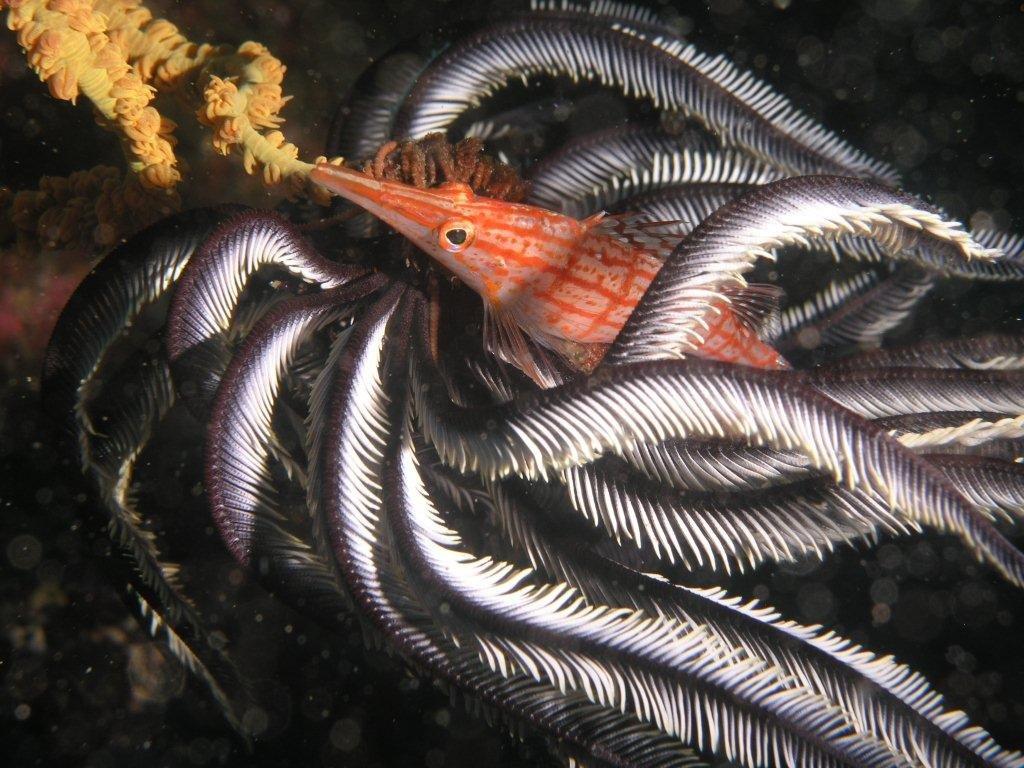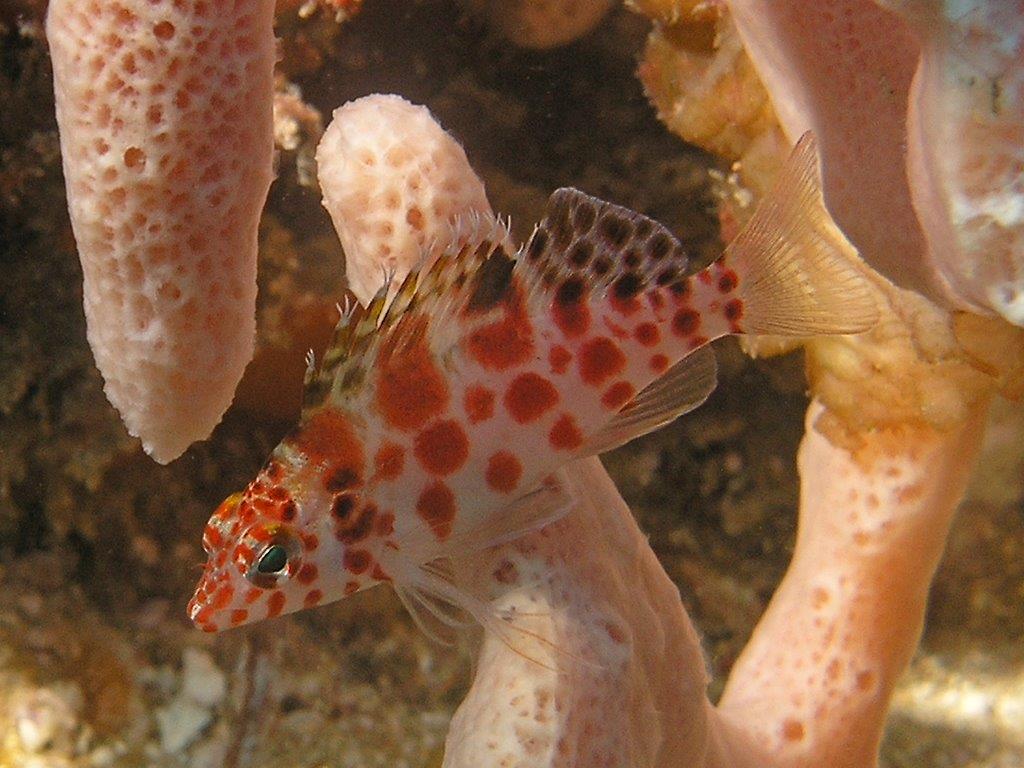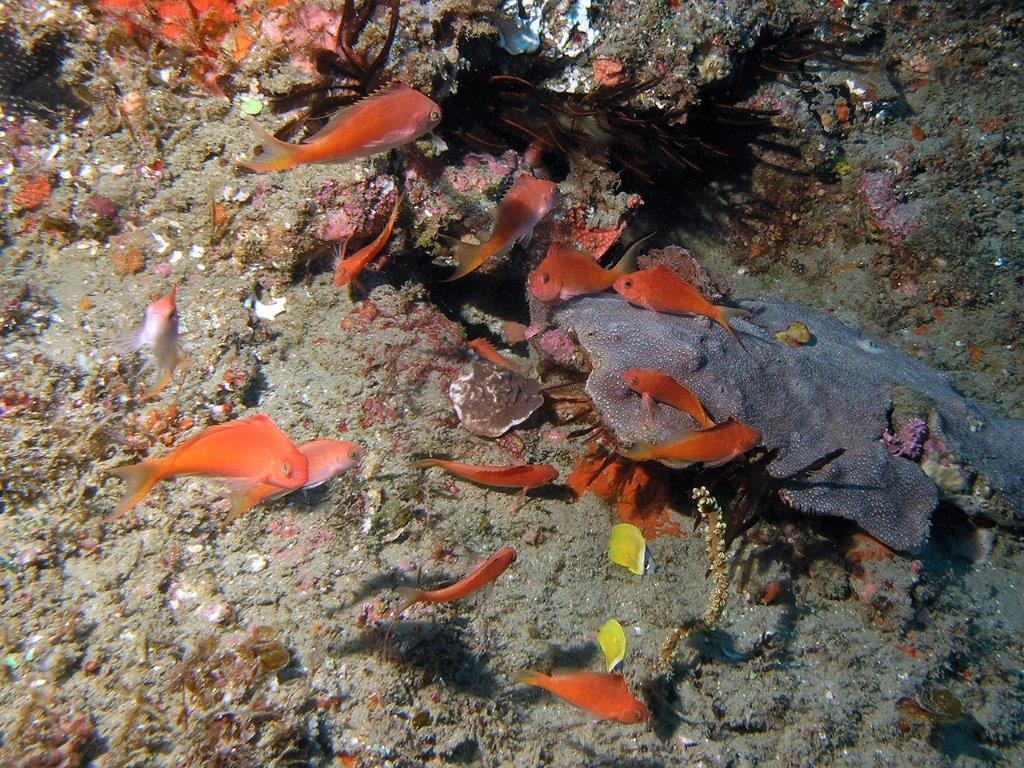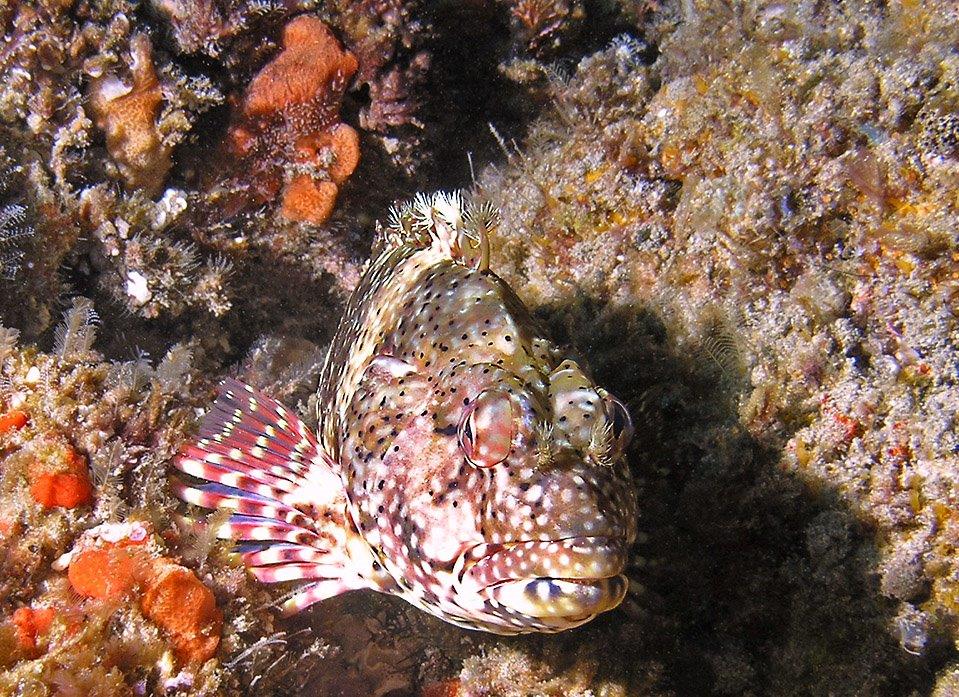Marine Life & Conservation
Hawk fish – Cirrhitidae

Hawk fishes are everywhere on the reef, perching on finger corals on shallow reefs, darting around the pinnacles in surge waters or perched motionless on a black coral in deep water.
Wherever you dive on shallow reefs, you will find the speckled hawk fish, also called Falco’s Hawkfish (Cirrhitichthys falco) perched on the finger corals, peering and gulping, poised to flit away. These little guys are colourful, easily spotted, and ready to hang about for photographs so they are a favourite with photographers. Their fleshless lower fins protect them from damage from the coral, and they can even perch on fire corals without being harmed.

Hawkfishes are grouper- like in appearance, and share many of the same features as the Scorpion fish family. However, unlike the Groupers or the Scorpion fish, the hawkfish does not have a swim bladder. Because of the lack of a swim bladder he is less able to adjust his buoyancy than normal fish, and perches in high places, just like a hawk, surveying his kingdom, waiting to dart down and grab a tasty morsel, feeding on crustaceans and small invertebrates.
He relies on propulsion to move from place to place, propelling himself from a higher position to reach a lower goal, and this darting swooping motion gives him his name, as he is quite bird-like in his movements. Normally solitary, you can occasionally find him as one of a pair towards evening, as it is in the evenings that you can find the hawkfish mating. This is quite a romantic ritual, as he waits for a fertile female, and entices her with his snout, cooing and weaving around her, until she is ready to ascend. At the highest point of the mating dance she releases her eggs, and he releases his sperm, which merge and sink down into the rubble bottom, to remain there as eggs until they are ready to hatch.
On deeper reefs you might be lucky enough to spot the swallow tail hawkfish (Cirrhitidae Polyactis). These are almost always found in groups. These little hawkfish are protogynous hermaphrodites, meaning that the largest female with become male once the dominant male dies, and takes over his harem.

In Mauritius we have often hunted for one of the most sought after of the hawk fish species, the rare and beautiful Long Nosed Hawkfish (Oxycirrhites typis Bleeker). Common in the Pacific, this little guy is an absolute jewel in Indian Ocean waters. Searching for him can take you down to 18-24 metres where sometimes, on the crystal white leaves of the Black coral which only grows below 18 metres you can occasionally, very rarely, find him. Coin de Mire in Mauritius is home to at least two of these rare little creatures.

Even more unusual is the Two spot hawk fish, and in 16 years of diving I have only ever seen two of these amazing little creatures. They are very shy, and hang out inside the Staghorn corals, so they are almost impossible to see, and as soon as you do see them they dart away.
The Marbled or Giant Hawk fish (Cirrhitus rivulatus). is caught commercially and sold as a food fish in some waters, but on the East Coast these guys are found in only surge waters, and on the East Coast there are very few places where they occur. They are brilliantly camouflaged, extremely timid and hard to spot.
I have had some of my most exciting dives hunting for these guys, as shallow surge reefs can be dangerous to divers. One of them is on the tightly controlled Quarter Mile reef at Sodwana Bay and hunting the Giant Hawkfish there is almost as exciting as looking for pregnant Ragged Tooth Sharks, who go there in December to gestate.

Words Jill Holloway
Pic David Holloway
Copyright Ocean Spirit
Blogs
The Ocean Cleanup Breaks 10,000,000 KG Barrier

The Ocean Cleanup, the global non-profit project, has removed a verified all-time total of ten million kilograms (22 million lbs.) of trash from oceans and rivers around the world – approximately the same weight as the Eiffel Tower.
To complete its mission of ridding the oceans of plastic, The Ocean Cleanup uses a dual strategy: cleaning up the Great Pacific Garbage Patch (GPGP) to remove the plastic already afloat in the oceans, while stopping the flow of plastic from the world’s most polluting rivers.
Through cleaning operations in the GPGP and in rivers in eight countries, the cumulative total of trash removed has now surpassed ten million kilograms. This milestone demonstrates the acceleration of The Ocean Cleanup’s impact, while underlining the astonishing scale of the plastic pollution problem and the need for continued support and action.
While encouraging for the mission, this milestone is only a staging point: millions more tons of plastic still pollute our oceans and The Ocean Cleanup intends to continue learning, improving and innovating to solve this global catastrophe.
This announcement comes as governments from around the world meet to continue negotiations to develop a new legally binding instrument to end plastic pollution at INC4 in Ottawa, Canada. Representatives of The Ocean Cleanup will be in attendance and the organization will be urging decision-makers to collaborate towards a comprehensive and ambitious global treaty which addresses plastic at all stages of its life cycle and in all marine environments worldwide, including in areas beyond national jurisdiction.
It is encouraging to see that the need for remediation is reflected in the various options for potential treaty provisions. It is essential that the final treaty contains clear targets for the remediation of legacy plastic pollution, and reduction of riverine plastic emissions.
Tackling plastic pollution requires innovative and impactful solutions. The treaty should therefore incentivize the innovation ecosystem by fostering innovations that make maximal use of data, technology and scientific knowledge – such as those designed and deployed by The Ocean Cleanup.
‘After many tough years of trial and error, it’s amazing to see our work is starting to pay off – and I am proud of the team who has brought us to this point.’ said Boyan Slat, Founder and CEO of The Ocean Cleanup. ‘While we still have a long way to go, our recent successes fill us with renewed confidence that the oceans can be cleaned.’
The Ocean Cleanup was founded in 2013 and captured its first plastic in 2019, with the first confirmed catch in the GPGP coming soon after the deployment of Interceptor 001 in Jakarta, Indonesia. After surpassing one million kilograms of trash removed in early 2022, the non-profit project has since progressed to the third iteration of its GPGP cleaning solution, known as System 03, and a network of Interceptors currently covering rivers in eight countries, with more deployments set for 2024.
About The Ocean Cleanup
The Ocean Cleanup is an international non-profit organization that develops and scales technologies to rid the world’s oceans of plastic. They aim to achieve this goal through a dual strategy: stemming the inflow via rivers and cleaning up the legacy plastic that has already accumulated in the ocean. For the latter, The Ocean Cleanup develops large-scale systems to efficiently concentrate the plastic for periodic removal. This plastic is tracked and traced through DNV’s chain of custody model to certify claims of origin when recycling it into new products. To curb the tide via rivers, The Ocean Cleanup has developed Interceptor™ solutions to halt and extract riverine plastic before it reaches the ocean. Founded in 2013 by Boyan Slat, The Ocean Cleanup now employs a broadly multi-disciplined team of approximately 140. The foundation is headquartered in Rotterdam, the Netherlands.
For more information, visit: theoceancleanup.com and follow @theoceancleanup on social media.
Marine Life & Conservation
Steve Backshall to headline Shark Trust’s flagship event: For the Love of Sharks

Join a host of amazing, shark loving, speakers including Steve Backshall and the Shark Trust team for an evening celebrating shark conservation at the Royal Geographical Society in London this November.
Date: 29th November 2024
Time: 6-10pm
Location: Royal Geographical Society, London
Tickets: https://www.sharktrust.org/Event/flos24
The event will be a celebration of all things shark. Those lucky enough to get hold of tickets will hear from engaging guest speakers with a passion for sharks.
The line-up includes (*subject to change if unforeseen circumstances arise)
Steve Backshall: One of television’s busiest presenters, BAFTA award-winning wildlife expert Steve has been passionate about the wild world ever since he was young.
Steve’s impressive TV career has taken him all around the world, investigating a wide array of species and environments. Steve has filmed over 100 hours of children’s wildlife programmes with the BAFTA award winning Deadly 60 franchise and recently, with Sky Nature, for his new series ‘Whale with Steve Backshall’. He has been a patron for the Shark Trust for 10 years.
Simon Rogerson: is a photojournalist specialising in natural history, diving and the sea.
He is editor of SCUBA magazine, the official journal of the British Sub-Aqua Club. Simon started his career as a crime reporter but gravitated towards his ‘less depressing’ interest in underwater exploration, joining the staff of DIVE magazine in 1999. In 2005 he was named ‘Editor of the Year’ in the PPA’s Independent Publishing Awards. Simon also works as a freelance writer, contributing frequently to the Sunday Times and Telegraph, in addition to BBC Wildlife, Esquire, and a host of international diving magazines. He is the author of a book, Dive Red Sea, published by Ultimate Sports. Now based in Berkshire, Simon has been a Patron of the Shark Trust for 20 years.
More speakers to be announced soon. Head to the Shark Trust website to learn more.
The evening will also allow guests the final chance to see the Oceanic 31, shark art exhibition. Some of the artwork will be auctioned/raffled at the event, while the rest will be auctioned online to raise money for the Shark Trust Oceanic Programme.
For the Love of Sharks is an evening with something for everyone who is interested and fascinated by sharks. Join the Shark Trust, their Patrons, Trustees and Staff, along with a host of supporters for this celebration of shark conservation.
For more information or to buy a ticket: https://www.sharktrust.org/Event/flos24
-

 News3 months ago
News3 months agoCapturing Critters in Lembeh Underwater Photography Workshop 2024: Event Roundup
-

 Marine Life & Conservation Blogs3 months ago
Marine Life & Conservation Blogs3 months agoCreature Feature: Swell Sharks
-

 Blogs2 months ago
Blogs2 months agoMurex Resorts: Passport to Paradise!
-

 Blogs2 months ago
Blogs2 months agoDiver Discovering Whale Skeletons Beneath Ice Judged World’s Best Underwater Photograph
-

 Gear Reviews3 weeks ago
Gear Reviews3 weeks agoGEAR REVIEW – Revolutionising Diving Comfort: The Sharkskin T2 Chillproof Suit
-

 Gear Reviews3 months ago
Gear Reviews3 months agoGear Review: Oceanic+ Dive Housing for iPhone
-

 News2 months ago
News2 months agoPADI Teams Up with Wellness Brand Neuro to Drive Ocean Change and Create a Blue State of Mind
-

 Marine Life & Conservation2 months ago
Marine Life & Conservation2 months agoSave the Manatee Club launches brand new webcams at Silver Springs State Park, Florida





